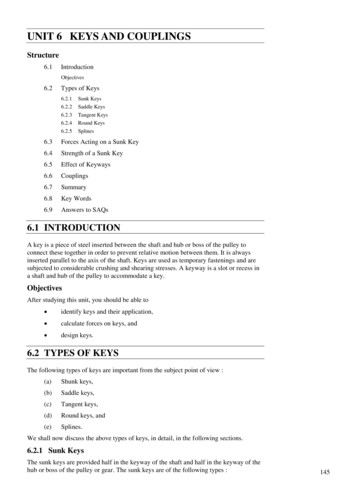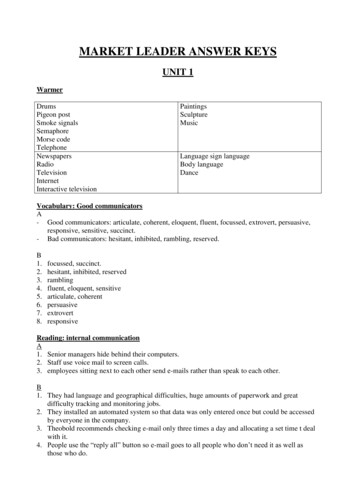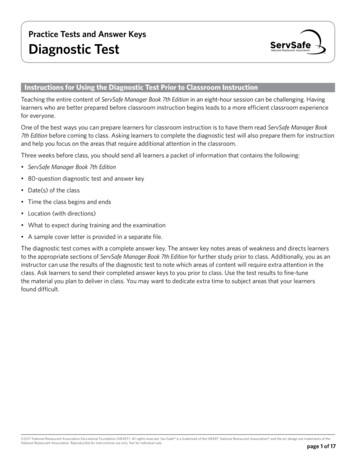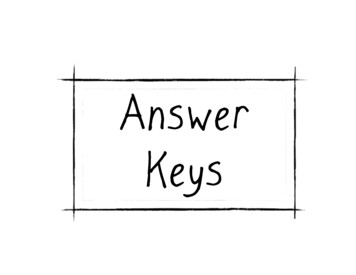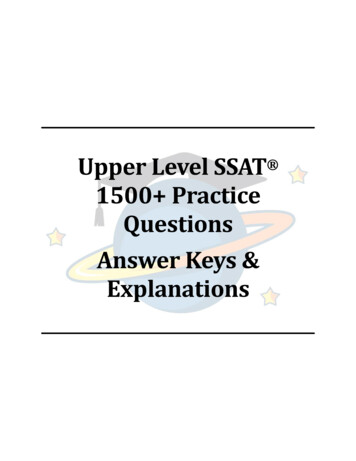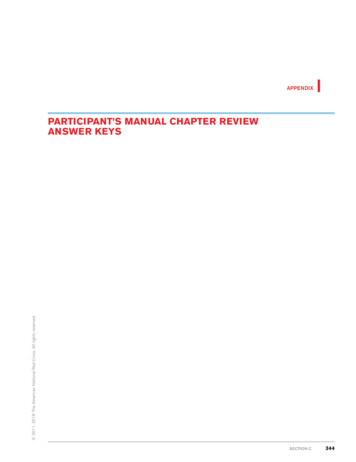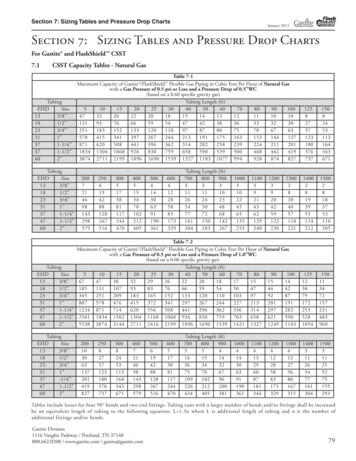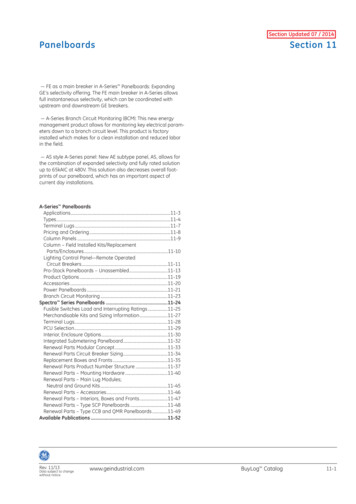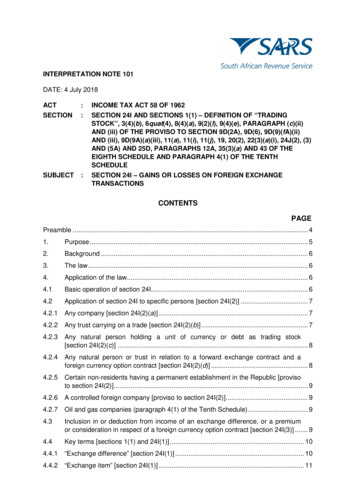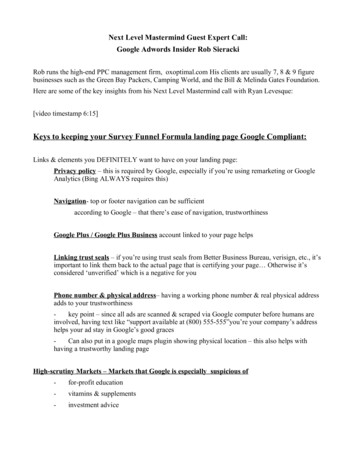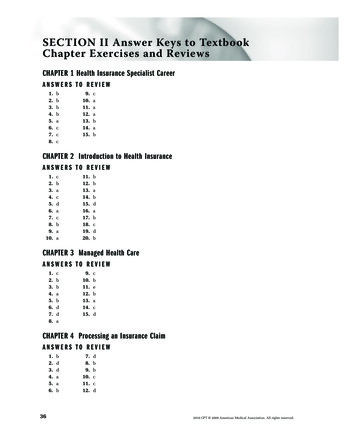
Transcription
SECTION II Answer Keys to TextbookChapter Exercises and ReviewsCHAPTER 1 Health Insurance Specialist CareerANSWERS TO caaababCHAPTER 2 Introduction to Health InsuranceANSWERS TO 5.16.17.18.19.20.bbabdabcdbCHAPTER 3 Managed Health CareANSWERS TO cbebacdCHAPTER 4 Processing an Insurance ClaimANSWERS TO REVIEW1.2.3.4.5.6.bddaab3635210 02 c02 p036-065.indd 367.8.9.10.11.12.dbbccd2010 CPT 2009 American Medical Association. All rights reserved.12/6/09 9:51:59 PM
SECTION II: Answer Keys to Textbook Chapter Exercises and 25.37addbdbCHAPTER 5 Legal and Regulatory IssuesREcOmmENdEd REadiNg: McWay, D. C. (2003). Legal aspects of health information management. 2nd ed. Clifton Park, NY:Delmar Learning.ANSWERS TO REVIEW1.2.3.4.5.dcaca6.7.8.9.10.babcbCHAPTER 6 ICD-9-CM CodingANSWERS TO ICD-9-CM CODING EXERCISES(The underlined word is the condition found in the Index to Diseases.)EXERCISE 6-1 Finding the Condition in the Index to Diseases1. Bronchiole spasm2. Congenital candidiasis (age 3)519.11771.7NOTE: Code 771.7 is assigned during the first 28 days of the patient’s life, and code 112.9 is assigned if the patient is older than28 days. (This exercise does not indicate the patient’s age. Therefore, either code is acceptable. In practice, review the medical recordto determine the patient’s age to assign the correct code.)3. Irritable bladder4. Earthquake injury(No site mentioned.See Injury in Index toExternal Causes)5. Exposure to AIDS6. Ground itch7. Nun’s knees8. Mice in right knee joint9. Contact dermatitis10. Ascending EXERCISE 6-2 Working with Coding Conventions (Index to Diseases)1.2.3.4.Acute purulent sinusitisFracture, mandibleActinomycotic meningitisPsychomotor akinetic epilepsy461.9 - (purulent) is a nonessential modifier802.20 - (closed) is a nonessential modifier039.8, 320.7 - sequence bracketed code second345.40 - requires fifth digit Delmar, Cengage Learning 201135210 02 c02 p036-065.indd 3712/6/09 9:52:00 PM
38SECTION II: Answer Keys to Textbook Chapter Exercises and Reviews5.6.7.8.3 cm laceration, right forearmContusion, abdomenPneumonia due to H. influenzaeDelayed healing, open wound, abdomen9. Bile duct cicatrix10. Uncontrolled type II diabetes mellituswith osteomyelitis881.00 - See also wound, open868.00 - NEC482.2 - H. influenzae is an essential modifier879.3 - Boxed Note describes “delayed healing”as “complicated”576.8 “Trust the Index.”250.82, 731.8 - Bracketed codeEXERCISE 6-3 Confirming Codes in the Tabular List of 3.22483.0795.71796.2718.06383.1Postinflammatory pulmonary fibrosisType II diabetesNontraumatic rupture of Achilles tendonAcute myocarditis due to Coxsackie virusMalunion, closed right radial fractureMycoplasmic pneumoniaPositive HIV test, asymptomaticElevated blood pressureOld tear of right knee meniscusTuberculous mastoiditisCE (250.00)CE (074.23)E (733.81)CE (V08)CE (717.5)E (015.60)EXERCISE 6-4 Working with Tabular List of Diseases Coding Conventions1. Pregnancy complicated by chronicgonorrhea; chronic gonococcalendometritis2. Benign neoplasm, ear cartilage3. Cervicitis, tuberculous4. Uncontrolled type II diabeteswith polyneuropathy5. Congenital hemangioma on face6. Hiss-Russell shigellosis7. Closed fracture, right leg8. Diabetic cataract9. Muscular atrophy, left leg10. Chronic smoker’s bronchitiswith acute bronchitis647.10 - fifth digit required098.36 - Use additional code215.0 - ear cartilage is not excluded016.70 - Includes250.62357.2 - Use additional code228.01 - Site is skin. Includes004.1 - “Trust the Index.”827.0 - NOS250.50, 366.41 - Use additional code728.2 - NEC466.0 (the acute disorder) and491.0 - Includes (the underlyingchronic condition)EXERCISE 6-5 Hypertension/Hypertensive Coding1.2.3.4.5.Essential hypertensionTransient hypertension due to pregnancyMalignant hypertensive crisisHeart disease with hypertensionOrthostatic hypertension, benign401.9642.30 (episode of care is not stated)401.0402.90401.1EXERCISE 6-6 Neoplasm Coding I1.2.3.4.Kaposi’s sarcomaLipoma, skin, upper backCarcinoma in situ, skin, left cheekScrotum mass176.9214.1232.3608.892010 CPT 2009 American Medical Association. All rights reserved.35210 02 c02 p036-065.indd 3812/6/09 9:52:00 PM
39SECTION II: Answer Keys to Textbook Chapter Exercises and Reviews5.6.7.8.9.10.NeurofibromaCyst on left ovaryGanglion right wristYaws, frambesideBreast, chronic cystic diseaseHürthle cell tumor215.9620.2727.41102.2610.1226EXERCISE 6-7 Neoplasm Coding II1. Ca (carcinoma) of the lung2. Metastasis from the lung(Neoplasms table)3. Abdominal mass4. Carcinoma of the breast (female)with metastasis to the axillarylymph nodes162.9162.9 (lung is primary),199.1 (unknown secondary site)789.30174.9, 196.3NOTE: The breast does not contain neuroendocrine cells, which means code 209.71 is not assigned. Neuroendocrine tumors arisein organs that contain specialized nerve cells that produce hormones, such as the pancreas.5. Carcinoma of axillary lymphnodes and lungs, metastaticfrom the breast (female)174.9 (breast is primary)196.3, 197.0 (secondary sites)EXERCISE 6-8 Using the Table of Drugs and Chemicals1. Adverse reaction to pertussis vaccine(Table of Drugs and Chemicals,Therapeutic)2. Cardiac arrhythmia caused byinteraction between prescribedephedrine and unprescribed alcohol(Table of Drugs and Chemicals,Poisoning)3. Stupor, due to overdose on Nytol(suicide attempt) (Table of Drugsand Chemicals, Poisoning, Suicide)4. High blood pressure due toprescribed Albuterol5. Rash due to combining prescribedAmoxicillin with nonprescribedBenadryl995.29 (unspecified adverse effect)E948.6 (therapeutic use)971.2 (poisoning, ephedrine), 980.0 (poisoning,alcohol), 427.9 (arrhythmia), E980.4, E980.9(undetermined external cause)963.0 (poisoning, Nytol), 780.09 (stupor), E950.4(suicide attempt)401.9 (hypertension)E945.7 (therapeutic use)960.0 (poisoning, Amoxicillin)963.0 (poisoning, Benadryl)E980.4 (undetermined external cause)693.0 (rash)EXERCISE 6-9 Exploring V Codes1. Family history of epilepsy withno evidence of seizures2. Six-week postpartum checkup3. Premarital physical (examination,marriage)4. Consult with dietitian for patientwith diabetes mellitus5. Rubella screeningV17.2V24.2V70.3V65.3, 250.00V73.3 Delmar, Cengage Learning 201135210 02 c02 p036-065.indd 3912/6/09 9:52:00 PM
40SECTION II: Answer Keys to Textbook Chapter Exercises and ReviewsEXERCISE 6-10 Coding HIV/AIDS and Fracture Cases1.2.3.4.5.Patient is HIV-positive with no symptomsAIDS patient treated for candidiasisOpen fracture, maxillaGreenstick fracture, third digit, right footMultiple fractures, right femur, distal endV08042, 112.9802.5826.0821.29EXERCISE 6-11 Coding Late Effects and Burns1. Malunion due to fracture, right ankle,9 months ago2. Brain damage due to subdural hematoma,18 months previously3. Second-degree burn, anterior chest wall4. Scalding with erythema, right forearmand hand5. Third-degree burn, back, 18 percentbody surface733.81, 905.4 (Late Effect)348.9, 438.9 (nontraumatic) or 907.0 (traumatic)(depending on documentation)942.22, 948.00 (extent of body surface burnedis 9 percent)943.11, 944.10, 948.00942.34, 948.11EXERCISE 6-12 Coding External Cause of Injury1. Automobile accident, highway, passenger2. Worker injured by fall from ladder3. Accidental drowning, fell frompower boat located on lake4. Soft tissue injury, right arm, due tosnowmobile accident in patient’s yard5. Fall from playground equipmentE819.1 (Accident, motor vehicle)E881.0 (fall from ladder), E849.9 (unspecifiedplace)994.1 (drowning), E832.1 (fall from boat), E849.8(other specified place)884.0, E820.9 (Accident, snow vehicle) andE849.0 (home)E884.0 (fall), E849.4 (playground)ANSWERS TO REVIEWInfectious and Parasitic Diseases (including HIV)1.2.3.4.5.6.Aseptic meningitis due to AIDSAsymptomatic HIV infectionSepticemia due to streptococcusDermatophytosis of the footMeasles; no complications notedNodular pulmonary tuberculosis;confirmed histologically7. Acute cystitis due to E. coli (infection)8. Tuberculosis osteomyelitis of lower leg, confirmed by histology9. Gas gangrene042, 047.8V08038.0110.4055.9011.15595.0, 041.4015.55, 730.86040.0NeoplasmsNOTE: Reference the ICD-9-CM Index to Diseases, and locate the condition documented in the diagnostic statement (e.g., melanoma). Then, follow the instructions to appropriately code each case (e.g., see also Neoplasm by site, malignant).10. Malignant melanoma of skin of scalp172.411. Lipoma of face214.012. Glioma of the parietal lobe of the brain (Neoplasm, brain, malignant, primary) 191.32010 CPT 2009 American Medical Association. All rights reserved.35210 02 c02 p036-065.indd 4012/6/09 9:52:00 PM
41SECTION II: Answer Keys to Textbook Chapter Exercises and Reviews13. Adenocarcinoma of prostate (Neoplasm, prostate, malignant, primary)14. Carcinoma in situ of vocal cord (Neoplasm, vocal cord, malignant,carcinoma in situ)15. Hodgkin’s granuloma of intra-abdominal lymph nodes and spleen185231.0201.18NOTE: One code is reported when multiple sites are positive for Hodgkin’s.16. Paget’s disease with infiltrating duct carcinoma of breast, nipple,and areola (Neoplasm, breast, malignant, primary)17. Liver cancer (Neoplasm, liver, malignant)174.8155.2NOTE: One code is reported when multiple regions of the same organ are positive for cancer.18. Metastatic adenocarcinoma from breast to brain (right mastectomyperformed five years ago) (Neoplasm, breast, malignant, primary, andNeoplasm, brain, malignant, secondary)19. Cancer of the pleura (primary site) (Neoplasm, pleura, malignant, primary)174.9,198.3 (in thisorder)163.9Endocrine, Nutritional and Metabolic Diseases, and Immunity Disorders20.21.22.23.24.25.26.27.28.29.Cushing’s SyndromeHypokalemiaType II diabetes mellitus, uncontrolled, with miaNephrosis due to type II diabetesToxic diffuse goiter with thyrotoxic crisisCystic fibrosisPanhypopituitarismRickets255.0276.8250.02, 263.9279.00272.0250.40, 581.81242.01277.00253.2268.0Diseases of the Blood and Blood-forming Organs30.31.32.33.34.35.36.37.38.39.Sickle cell disease with crisisIron deficiency anemia secondary to blood lossVon Willebrand’s diseaseChronic congestive splenomegalyCongenital nonspherocytic hemolytic anemiaEssential thrombocytopeniaMalignant neutropeniaFanconi’s anemiaMicroangiopathic hemolytic anemiaAplastic anemia secondary toantineoplastic medication for breast 9283.19285.3174.9, E933.1Mental Disorders40.41.42.43.Acute exacerbation of chronic undifferentiated schizophreniaReactive depressive psychosis due to the death of a childHysterical neurosisAnxiety reaction manifested by fainting (do not codefainting because it is a symptom)44. Alcoholic gastritis due to chronic alcoholism (episodic)45. Juvenile delinquency; patient was caught shoplifting295.64298.0300.10300.00535.30, 303.92312.9 Delmar, Cengage Learning 201135210 02 c02 p036-065.indd 4112/6/09 9:52:01 PM
42SECTION II: Answer Keys to Textbook Chapter Exercises and Reviews46.47.48.49.DepressionHypochondria; patient also has continuous laxative habitAcute senile dementia with Alzheimer’s disease (in this order)Epileptic psychosis with generalized grand mal epilepsy311300.7, 305.91331.0, 294.10294.8, 345.10Diseases of the Nervous System and Sense Organs50.51.52.53.Neisseria meningitisIntracranial abscessPostvaricella encephalitisHemiplegia due to old CVA036.0324.0052.0438.20NOTE: 342.9x is assigned to hemiplegia if not associated with old CVA.54.55.56.57.58.59.EncephalitisRetinal detachment with retinal defectCongenital diplegic cerebral palsyTonic-clonic epilepsyInfantile glaucomaMature cataract323.9361.00343.0345.10365.14366.9Diseases of the Circulatory System60.61.62.63.64.65.66.Congestive rheumatic heart failureMitral valve stenosis with aortic valve insufficiencyAcute rheumatic heart diseaseHypertensive cardiovascular disease, malignantCongestive heart failure; benign hypertensionSecondary benign hypertension; stenosis of renal arteryMalignant hypertensive nephropathy with uremia (Uremia is renalfailure, code 586, which is not assigned because it is included in 403.01)67. Acute renal failure; essential hypertension (no cause-and-effect relationshipbetween the renal failure and hypertension; therefore, two codes are reported)68. Acute myocardial infarction of inferolateral wall, initial episode of care69. Arteriosclerotic heart disease (native coronary artery) with angina pectoris398.91396.1391.9402.00428.0, 401.1405.11, 440.1403.01584.9, 401.9410.21414.01, 413.9Diseases of the Respiratory System70.71.72.73.74.Aspiration pneumonia due to regurgitated foodStreptococcal Group B pneumoniaRespiratory failure due to myasthenia gravis (in this order)Intrinsic asthma in status asthmaticusCOPD with emphysema (do not assign 496;see note at code 496 in ICD-9-CM Tabular List)507.0482.32518.81, 358.00493.11492.8Diseases of the Digestive System75.76.77.78.79.80.Supernumerary toothUnilateral femoral hernia with gangreneCholesterolosis of gallbladderDiarrheaAcute perforated peptic ulcerAcute hemorrhagic gastritis with acute blood loss anemia520.1551.00575.6787.91533.10535.01, 285.1 2010 CPT 2009 American Medical Association. All rights reserved.35210 02 c02 p036-065.indd 4212/6/09 9:52:01 PM
43SECTION II: Answer Keys to Textbook Chapter Exercises and Reviews81.82.83.84.85.Acute appendicitis with perforation and peritoneal abscessAcute cholecystitis with cholelithiasisAphthous stomatitisDiverticulosis and diverticulitis of colonEsophageal reflux with esophagitis540.1574.00528.2562.11530.11Diseases of the Genitourinary System86. Vesicoureteral reflux with bilateral reflux nephropathy87. Acute glomerulonephritis with necrotizing glomerulolitis88. Actinomycotic cystitis89. Subserosal uterine leiomyoma, cervical polyp, and endometriosis of uterus90. Dysplasia of the cervix593.72580.4039.8, 595.4(in this order)218.2, 622.7,617.0622.10Diseases of Pregnancy, Childbirth, and the Puerperium91. Defibrination syndrome following termination of pregnancy (TOP)procedure two weeks ago (see Excludes note at 286.6 regardingTOP procedure)92. Miscarriage at 19 weeks gestation93. Incompetent cervix resulting in miscarriage and fetal death94. Postpartum varicose veins of legs95. Spontaneous breech delivery96. Triplet pregnancy, delivered spontaneously97. Retained placenta without hemorrhage, delivery this admission98. Pyrexia of unknown origin during the puerperium (postpartum),delivery during previous admission99. Late vomiting of pregnancy, undelivered100. Pre-eclampsia complicating pregnancy, delivered this admission639.1634.90634.91, 654.53671.04652.21, V27.9651.11, V27.9667.02672.04643.23642.41, V27.9Diseases of the Skin and Subcutaneous Tissue101.102.103.104.105.Diaper rashAcne vulgarisPost-infectional skin cicatrixCellulitis of the foot; culture reveals staphylococcusInfected ingrowing nail691.0706.1709.2682.7, 041.10703.0Diseases of the Musculoskeletal System and Connective Tissue106.107.108.109.110.Displacement of thoracic intervertebral discPrimary localized osteoarthrosis of the hipAcute juvenile rheumatoid arthritisChondromalacia of the patellaPathologic fracture of the vertebra due to metastaticcarcinoma of the bone from the lung722.11715.15714.31717.7733.13, 198.5,162.9NOTE: The lung does not contain neuroendocrine cells, which means code 209.73 is not assigned. Neuroendocrine tumors arise in organs thatcontain specialized nerve cells that produce hormones, such as the pancreas. Delmar, Cengage Learning 201135210 02 c02 p036-065.indd 4312/6/09 9:52:01 PM
44SECTION II: Answer Keys to Textbook Chapter Exercises and ReviewsCongenital Anomalies111. Congenital diaphragmatic hernia112. Single liveborn male (born in the hospital) with polydactylyof fingers (newborn)113. Unilateral cleft lip and palate114. Patent ductus arteriosus115. Congenital talipes equinovalgus756.6V30.00,779.89, 755.01749.22747.0754.69Certain Conditions Originating in the Perinatal Period116.117.118.119.120.Erythroblastosis fetalisHyperbilirubinemia of prematurity, prematurity (birthweight 2,000 grams)Erb’s palsyHypoglycemia in infant with diabetic motherPremature “crack” baby born in hospital to cocaine-dependentmother (birthweight 1,247 grams)773.2774.2, 765.18767.6775.0765.14, 760.75,779.5, 304.20Symptoms, Signs, and Ill-defined Conditions121.122.123.124.Abnormal cervical Pap smearSudden infant death syndromeSleep apnea with insomniaFluid retention and edema (edema is coded because of Excludesnote associated with 276.6)125. Elevated blood pressure reading795.00798.0780.51276.6, 782.3796.2Injury and PoisoningFractures, Dislocations, and Sprains126. Open frontal fracture with subarachnoid hemorrhage with briefloss of consciousness127. Supracondylar fracture of right humerus and fractureof olecranon process of the right ulna128. Anterior dislocation of the elbow129. Dislocation of the first and second cervical vertebrae130. Sprain of lateral collateral ligament of knee800.72812.41, 813.01832.01839.08844.0Open Wounds and Other sion of eyeTraumatic below-the-knee amputation with delayed healingOpen wound of buttockOpen wound of wrist involving tendonsLaceration of external earTraumatic subdural hemorrhage with open intracranial wound;loss of consciousness, 30 minutesConcussion without loss of consciousnessTraumatic laceration of the liver, moderateTraumatic hemothorax with open wound into thorax and concussionwith loss of consciousnessTraumatic duodenal injury 4.03860.3, 850.5863.21 2010 CPT 2009 American Medical Association. All rights reserved.35210 02 c02 p036-065.indd 4412/6/09 9:52:01 PM
SECTION II: Answer Keys to Textbook Chapter Exercises and Reviews45Burns141. Third-degree burn of lower leg and second-degree burn of thigh142.143.144.145.Deep third-degree burn of forearmThird-degree burns of back involving 20 percent of body surfaceThirty percent body burns with 10 percent third-degreeFirst- and second-degree burns of ,948.00948.22948.00Foreign Bodies146. Coin in the bronchus with bronchoscopy for removal ofthe coin (foreign body, entering through orifice)147. Foreign body in the eye (entering through orifice)148. Marble in colon (foreign body, entering through orifice)149. Bean in nose (foreign body, entering through orifice)150. Q-tip stuck in ear (foreign body, entering through orifice)934.1930.9936932931Complications151. Infected ventriculoperitoneal shunt (Complication, infection,ventricular shunt)152. Displaced breast prosthesis (Complication, mechanical, implant,prosthetic, in breast)153. Leakage of mitral valve prosthesis (Complication,mechanical, heart valve prosthesis)154. Postoperative superficial thrombophlebitis of the right leg155. Dislocated hip prosthesis (Complication, orthopedic device,internal, mechanical)996.63996.54996.02997.2, 451.0996.42V 67.168.169.170.171.172.Exposure to tuberculosisFamily history of colon carcinomaStatus (post) unilateral kidney transplant, human donorEncounter for removal of cast (plaster cast)Admitted to donate bone marrow (donor)Encounter for chemotherapy for patient with Hodgkin’s lymphomaReprogramming of cardiac pacemakerReplacement of tracheostomy tube (Attention to)Encounter for renal dialysis for patient in chronic renal failureEncounter for speech therapy for patient with dysphasia secondaryto an old CVA (late effect)Encounter for fitting of artificial legEncounter for observation of suspected malignant neoplasm of the cervixVisit to radiology department for barium swallow; abdominal pain; bariumswallow performed and the findings are negativeFollow-up examination of colon adenocarcinoma resected one year ago,no recurrence found (history, personal, of)Routine general medical examinationExamination of eyesEncounter for laboratory test; patient complains of fatigueV01.1V16.0V59.4V54.89V59.3V58.11, 201.90V53.31V55.0V56.0, 585.9V57.3, 438.12V52.1V71.1V67.09, V10.05V70.0V72.0780.79NOTE: Do not report code V72.6 because the symptom, fatigue, is documented as the reason for laboratory testing. Delmar, Cengage Learning 201135210 02 c02 p036-065.indd 4512/6/09 9:52:01 PM
46SECTION II: Answer Keys to Textbook Chapter Exercises and Reviews173. Encounter for physical therapy; status post below-the-kneeamputation six months ago174. Kidney donor175. Encounter for chemotherapy; breast carcinoma (ICD-9-CM code V58.11was added in 2006.)V57.1, V45.89V59.4V58.11, 174.9Coding Late Effects176.177.178.179.180.181.X 182.183.XXXXHemiplegia due to previous cerebrovascular accidentMalunion of fracture, right femurScoliosis due to infantile paralysisKeloid secondary to injury nine months agoGangrene, left foot, following third-degree burn of foot two weeks agoCerebral thrombosis with hemiplegiaMental retardation due to previous viral encephalitisLaceration of tendon of finger two weeks ago. Admitted now for tendon repairNOTE: Refer first to the ICD-9-CM Index to Diseases main term, Late (effect), for each diagnosis below. When the sequela (residual or resulting problem) isdocumented, report that code first followed by the late effect code.184.185.186.187.188.189.190.Residuals of poliomyelitisSequela of old crush injury to left footCerebrovascular accident two years ago with late effectsEffects of old gunshot wound, left thighDisuse osteoporosis due to previous poliomyelitisBrain damage following cerebral abscess seven months agoHemiplegia due to old cerebrovascular accident138906.4438.9906.1733.03, 138348.9, 326438.20NOTE: Adverse reactions occur when patients take a prescribed medication, and a reaction develops. The first code reported is the adverse reaction (e.g., rash),and subsequent code(s) report the drug(s) taken, located in the Therapeutic Use column of the Table of Drugs and Chemicals. Poisonings occur when patientstake a nonprescribed medication or combine prescribed with nonprescribed medications or drugs/alcohol. The first code reported is the poisoning code located inthe first column of the Table of Drugs and Chemicals, and subsequent code(s) report the drug(s) and/or substance(s) (e.g., alcohol) (E-codes from the remainingcolumns in the Table of Drugs and Chemicals).Adverse Reactions and Poisonings191. Ataxia due to interaction between prescribed carbamazepineand erythromycin (Adverse Reaction)192. Vertigo as a result of dye administered for a scheduledIVP (Adverse Reaction)193. Accidental ingestion of mother’s oral contraceptives(no signs or symptoms resulted) (Poisoning)194. Hemiplegia; patient had an adverse reaction to prescribedEnovid one year ago (Late Effect of Adverse Reaction)195. Stricture of esophagus due to accidental lye ingestion three yearsago (Late Effect of Adverse Reaction)196. Listlessness resulting from reaction between prescribed Valiumand ingestion of a six-pack of beer (Poisoning)197.198.199.200.Lead poisoning (child had been discovered eating paint chips) (Poisoning)Allergic reaction to unspecified drug (Adverse Reaction)Theophylline toxicity (Adverse Reaction)Carbon monoxide poisoning from car exhaust (suicide attempt) (Poisoning)781.3, E936.3,E930.3780.4, E947.8962.2, E858.0342.90, 909.5,E932.2530.3, 909.1,E929.2969.4, 980.0,780.79, E980.9,E980.3984.0, E980.9995.20, E935.9995.29, E944.1986, E952.02010 CPT 2009 American Medical Association. All rights reserved.35210 02 c02 p036-065.indd 4612/6/09 9:52:02 PM
SECTION II: Answer Keys to Textbook Chapter Exercises and Reviews47CHAPTER 7 CPT CodingANSWERS TO CPT CODING EXERCISESEXERCISE 7-1 Working with CPT Symbols and ConventionsNOTE: The underlined words indicate key terms in the index. Words in parentheses are word substitutions to help you locate the procedure/service in theindex, and they provide explanations of special coding situations.1. F2.3.4.5.6.7.FFTTFF8. T9. T10. FThe major sections of CPT are evaluation and management, anesthesia, surgery, pathologyand laboratory, radiology, and medicine.The triangle indicates a code description revision.CPT requires a two-digit modifier to be attached to the five-digit CPT code.“Notes” should be applied to all codes located under a heading.Semicolons save space in CPT where a series of related codes are found.Qualifiers may appear in the main and subordinate clauses.Parenthetical statements beginning with “eg” provide examples of terms that may beincluded in the healthcare provider’s documentation of services/procedures performed.Horizontal triangles (ut) are found in revised guidelines, notes, and proceduredescriptions.The bullet ( ) located to the left of a CPT code indicates a code new to that edition of CPT.Code 50620 would be reported for a ureterolithotomy performed on the middle one-third ofthe ureter.EXERCISE 7-2 Working with the CPT Index1. Marsupialization means creating a pouch to exteriorize a cyst.2. 47350Management of liver hemorrhage; simple suture of liver wound or injury47360complex suture of liver wound or injury, with or without hepatic artery ligation47361exploration of hepatic wound, extensive debridement, coagulation and/or suture,without packing of liver47362re-exploration of hepatic wound for removal of packing3. T4. FMain terms appear in boldface in the CPT index.5. FInferred words do not appear in the CPT index.EXERCISE 7-3 Assigning CPT Modifiers1. Assistant surgeon reporting patient’s cesarean section, delivery only.2. Cholecystectomy reported during postoperative period fortreatment of leg fracture.3. Treatment for chronic conditions at same time preventivemedicine is provided.4. Inpatient visit performed by surgeon, with decision to performsurgery tomorrow.5. Office consultation as preoperative clearance for surgery.6. Postoperative management of vaginal hysterectomy.7. Repeat gallbladder x-ray series, same physician.8. Arthroscopy of right elbow and closed fracture reduction of left wrist.9. Needle core biopsy of right and left breast.10. Consultation required by 0–32 Delmar, Cengage Learning 201135210 02 c02 p036-065.indd 4712/6/09 9:52:02 PM
48SECTION II: Answer Keys to Textbook Chapter Exercises and ReviewsEXERCISE 7-4 Finding Procedures in the Index1. Closed treatment of wrist dislocation2. Dilation of cervix (See Dilation and Curettage)3. Placement of upper GI feeding tube (Placement, Nasogastric Tube)4. Radiograph and fluoroscopy of chest, four views(See Radiology, Diagnostic; x-ray)x-ray, Chest, Complete (Four Views), with Fluoroscopy5. Magnetic resonance imaging (MRI), lower spine6. Darrach procedure (See Excision, Ulna, Partial)7.8.9.10.Manual CBC (See Blood Cell Count, Complete Blood Count [CBC])Electrosurgical removal, skin tagsMolar pregnancy excision (See Hydatidiform Mole)Muscle denervation, hip joint25660, 25675,2568057558, 200-112015910027035EXERCISE 7-5 Evaluation and Management 8.19.20.Home visit, problem focused, established patientED service, new patient, low complexity (Emergency Department Services)Hospital care, new patient, initial, high complexityHospital care, subsequent, detailedED care, problem focused, counseling 15 minutes.(Emergency Department Services)Patient requested consultation, new patient, moderate complexityOffice consultation, high complexity, established patient, surgeryscheduled tomorrowFollow-up consultation, office, problem focused, counseling 15 minutes,encounter was 25 minutes. (There is no follow-up outpatient consult;use Est. Office Visit. Counseling becomes the key factor, selection isbased on time.)Follow-up consultation, inpatient, detailed, 35 minutesBlood pressure check by nurse (established patient).(Office and/or Other Outpatient Services)New patient, routine preventive medicine, age 11. Risk factordiscussion, 20 minutesCritical care, 1.5 hours (Critical Care Services)Nursing facility visit, subsequent visit, expanded problem focused H&PEMedical team conference, 50 minutes, nurse practitionerand discharge plannerFollow-up visit, ICU patient, stable, expanded problem focused H&PE(Patient is stable, use subsequent inpatient category.)Resuscitation of newborn in delivery roomTelephone E/M service by physician to established patient, 10 minutesCustodial care, established patient, detailed H&PE, highcomplexity (CPT code 99336 was added in 2006.)Pediatrician on standby, high-risk birth, 65 minutesHeart risk factor education, group counseling, asymptomatic attendees,65 minutes (Preventive 9253992119938399291, 9929299308993689923299465994419933699360, 99360994122010 CPT 2009 American Medical Association. All rights reserved.35210 02 c02 p036-065.indd 4812/6/09 9:52:02 PM
49SECTION II: Answer Keys to Textbook Chapter Exercises and ReviewsEXERCISE 7-6 Anesthesia -QX-P101744-QZ-P31. Anesthesiologist provided anesthesia services to a 77-year-old female patient whoreceived a corneal transplant. The patient has a history of prior stroke.2. Anesthesiologist provided anesthesia services to a 50-year-old diabetic patientwho underwent direct coronary artery bypass grafting.3. Anesthesiologist provided anesthesia services for hernia repair in the lower abdomen of an otherwise healthy 9-month-old infant.4. CRNA provided anesthesia services under physician direction during an extensive procedure on the cervical spine of an otherwise healthy patient.5. CRNA provided anesthesia services to a morbidly obese female patient whounderwent repair of malunion,
ANSWERS TO REVIEW 1. b 9. c 2. b 10. a 3. b 11. a 4. b 12. a 5. a 13. b 6. c 14. a 7. c 15. b 8. c CHAPTER 2 Introduction to Health Insurance ANSWERS TO REVIEW 1. c 11. b 2. b 12. b 3. . chronic gonococcal 098.36 - Use additional code endometritis 2. Benign neoplasm, ear cartilag
